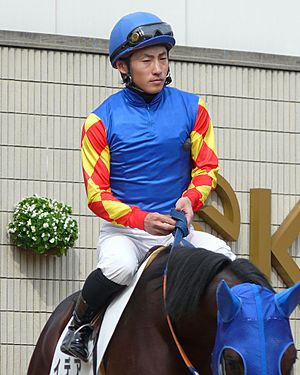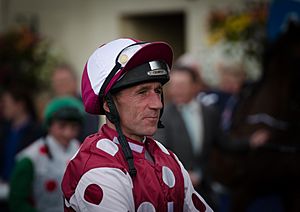Jockey facts for kids
A jockey is a person who rides horses in horse racing. They are professional athletes who guide powerful horses around a track. The word "jockey" can also be used for people who ride camels in camel racing.
Contents
What Jockeys Do
Jockeys are usually self-employed. This means they work for themselves. Horse trainers choose jockeys to ride their horses in races. Jockeys get paid a fee for each race they ride in. They also earn a percentage of the prize money if their horse wins.
Jockeys often start their careers when they are young. They begin as "apprentice jockeys." This means they are learning the ropes. They ride horses during morning training sessions. Before they can race, apprentices must successfully ride in many practice races.
Becoming a Jockey
An apprentice jockey is sometimes called a "bug boy." This is because a small star, like a bug, appears next to their name in the race program. All jockeys must have a special license to race. They are usually not allowed to bet on races.
After about four years of training, an apprentice becomes a senior jockey. They often build strong relationships with trainers and specific horses. Sometimes, a senior jockey might be paid a regular fee by a horse owner. This means the jockey will always ride that owner's horses in races.
Many jockeys continue their careers in horse racing after they stop riding. They might become horse trainers, for example. This system helps young people find jobs in the racing world.
Physical Requirements for Jockeys
Jockeys need to be very light. This is because there are strict weight limits for horses in races. For example, in the Kentucky Derby, a horse can only carry 126 lb (57 kg). This weight includes the jockey and their equipment.
Most jockeys weigh between 108 to 118 lb (49 to 54 kg). Even though they are light, they must be very strong. They need to control a horse that can run at 40 mph (64 km/h). These horses can weigh as much as 1,200 lb (540 kg)!
There is no official height limit for jockeys. However, because of the weight limits, jockeys are usually quite short. Most jockeys are between 4 ft 10 in (147 cm) and 5 ft 6 in (168 cm) tall.
Racing Colors and Silks
The colorful outfits jockeys wear are called "racing colors." These colors are registered to the horse's owner or trainer. The idea of riders wearing special colors might come from old times. Knights in medieval jousting tournaments also wore unique colors.
In the United States, people often call the whole outfit "silks." However, technically, "silks" only refers to the white pants and neck scarf (called a cravat). When a jockey rides in their first race, wearing these silken pants and colors is a special moment.
Long ago, these outfits were always made of real silk. Silk was chosen because it is a very light fabric. Today, synthetic materials are used instead. The racing colors and silks are important symbols. They show loyalty to the horse's owner and add to the excitement of the race.
Images for kids
-
Toulouse-Lautrec - The Jockey (1899)
See also
 In Spanish: Jockey para niños
In Spanish: Jockey para niños










